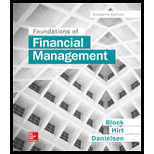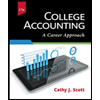
Foundations of Financial Management
16th Edition
ISBN: 9781259277160
Author: Stanley B. Block, Geoffrey A. Hirt, Bartley Danielsen
Publisher: McGraw-Hill Education
expand_more
expand_more
format_list_bulleted
Question
Chapter 2, Problem 13P
Summary Introduction
To Explain: Whether the items are non-current or current assets.
Introduction:
Non-Current Assets
Non-current assets are ones that cannot be converted into cash within the current financial year and take time for their realization.
Non-Current Liabilities
They are ones that are not obligated to be paid during the current financial year.
Current Assets
They are ones that can be liquidated or converted into cash easily within the current accounting period.
Current Liabilities
They are ones that are obligated to be paid during the current financial year.
Expert Solution & Answer
Trending nowThis is a popular solution!

Students have asked these similar questions
Assume a firm has earnings before depreciation and taxes of $200,000 and no depreciation. It is in a 25 percent tax bracket.
a. Compute its cash flow using the following format:
Earnings before depreciation and taxes _____Depreciation _____Earnings before taxes _____Taxes @ 25% _____Earnings after taxes _____Depreciation _____Cash Flow _____
b. Compute the cash flow for the company if depreciation is $200,000.
Earnings before depreciation and taxes _____Depreciation _____Earnings before taxes _____Taxes @ 25% _____Earnings after taxes _____Depreciation _____Cash Flow _____
c. How large a cash flow benefit did the depreciation provide?
Assume a $40,000 investment and the following cash flows for two alternatives.
Year Investment X Investment Y 1 $6,000 $15,000 2 8,000 20,000 3 9,000 10,000 4 17,000 — 5 20,000 —
Which of the alternatives would you select under the payback method?
The Short-Line Railroad is considering a $140,000 investment in either of two companies. The cashflows are as follows:Year Electric Co. Water Works1.................. $85,000 $30,0002.................. 25,000 25,0003.................. 30,000 85,0004–10............ 10,000 10,000a. Using the payback method, what will the decision be?b. Using the Net Present Value method, which is the better project? The discount rate is 10%.
Chapter 2 Solutions
Foundations of Financial Management
Ch. 2 - Discuss some financial variables that affect the...Ch. 2 - What is the difference between book value per...Ch. 2 - Explain how depreciation generates actual cash...Ch. 2 - What is the difference between accumulated...Ch. 2 - How is the income statement related to the balance...Ch. 2 - Prob. 6DQCh. 2 - Explain why the statement of cash flows provides...Ch. 2 - What are the three primary sections of the...Ch. 2 - Prob. 9DQCh. 2 - Why is interest expense said to cost the firm...
Ch. 2 - Frantic Fast Foods had earnings after taxes of...Ch. 2 - Sosa Diet Supplements had earnings after taxes of...Ch. 2 - a. Swank Clothiers had sales of $383,000 and cost...Ch. 2 - Prob. 4PCh. 2 - Prob. 5PCh. 2 - Given the following information, prepare an income...Ch. 2 - Prob. 7PCh. 2 - Prob. 8PCh. 2 - Prepare an income statement for Virginia Slim...Ch. 2 - Prob. 10PCh. 2 - Stein Books Inc. sold 1,900 finance textbooks for...Ch. 2 - Lemon Auto Wholesalers had sales of $1,000,000...Ch. 2 - Prob. 13PCh. 2 - Fill in the blank spaces with categories 1 through...Ch. 2 - Arrange the following items in proper balance...Ch. 2 - Elite Trailer Parks has an operating profit of...Ch. 2 - Quantum Technology had $669,000 of retained...Ch. 2 - Botox Facial Care had earnings after taxes of...Ch. 2 - Stilley Corporation had earnings after taxes of...Ch. 2 - Prob. 20PCh. 2 - The Rogers Corporation has a gross profit of...Ch. 2 - Nova Electrics anticipates cash flow from...Ch. 2 - Prob. 23PCh. 2 - Prob. 24PCh. 2 - Prob. 25PCh. 2 - Prob. 26PCh. 2 - For December 31, 20X1, the balance sheet of Baxter...Ch. 2 - Refer to the following financial statements for...Ch. 2 - Scroll all the way down to “Financials� and...Ch. 2 - Now click on “Balance Sheet� and compute the...Ch. 2 - Prob. 4WE
Knowledge Booster
Similar questions
- What do you know about corporate finance? tell me about thisarrow_forwardWhich of the following is the primary function of insurance? Making risk disappear. Pooling and sharing risk among the insured. Making someone else pay for an accident or loss. Don’t know.arrow_forwardwhat is the corporate finance? explain allarrow_forward
arrow_back_ios
SEE MORE QUESTIONS
arrow_forward_ios
Recommended textbooks for you
- Century 21 Accounting Multicolumn JournalAccountingISBN:9781337679503Author:GilbertsonPublisher:Cengage
 College Accounting, Chapters 1-27AccountingISBN:9781337794756Author:HEINTZ, James A.Publisher:Cengage Learning,
College Accounting, Chapters 1-27AccountingISBN:9781337794756Author:HEINTZ, James A.Publisher:Cengage Learning,  Cornerstones of Financial AccountingAccountingISBN:9781337690881Author:Jay Rich, Jeff JonesPublisher:Cengage Learning
Cornerstones of Financial AccountingAccountingISBN:9781337690881Author:Jay Rich, Jeff JonesPublisher:Cengage Learning College Accounting (Book Only): A Career ApproachAccountingISBN:9781337280570Author:Scott, Cathy J.Publisher:South-Western College PubPrinciples of Accounting Volume 1AccountingISBN:9781947172685Author:OpenStaxPublisher:OpenStax College
College Accounting (Book Only): A Career ApproachAccountingISBN:9781337280570Author:Scott, Cathy J.Publisher:South-Western College PubPrinciples of Accounting Volume 1AccountingISBN:9781947172685Author:OpenStaxPublisher:OpenStax College

Century 21 Accounting Multicolumn Journal
Accounting
ISBN:9781337679503
Author:Gilbertson
Publisher:Cengage

College Accounting, Chapters 1-27
Accounting
ISBN:9781337794756
Author:HEINTZ, James A.
Publisher:Cengage Learning,


Cornerstones of Financial Accounting
Accounting
ISBN:9781337690881
Author:Jay Rich, Jeff Jones
Publisher:Cengage Learning

College Accounting (Book Only): A Career Approach
Accounting
ISBN:9781337280570
Author:Scott, Cathy J.
Publisher:South-Western College Pub

Principles of Accounting Volume 1
Accounting
ISBN:9781947172685
Author:OpenStax
Publisher:OpenStax College